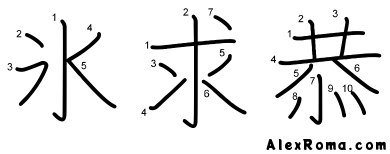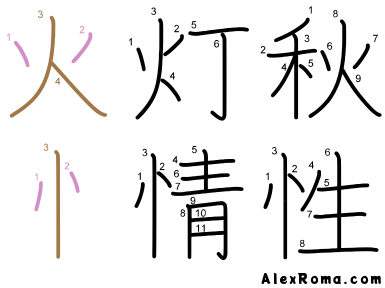Stroke order rule 5 – prominent middle first
Some shapes and kanji find their balance through a central prominent stroke (or strokes) that acts as a centre of gravity. Smaller satellite strokes are located on the left and the right side of the central stroke, forming a balanced/symmetrical shape.
See the diagram below.

The brown stroke in 小 chiisai acts as the centre of gravity, or what I call the “prominent middle”. The two red strokes are the satellites. Stroke order rule 5 says:
When a prominent middle stroke (or group of strokes) is surrounded by symmetrical satellite shapes, the prominent middle stroke is written first.
Stating the obvious, the remaining satellite strokes are written left to right, and top to bottom, as usual. It is also important to notice that the satellite strokes don’t have to be exactly symmetrical, as in 水 mizu, where the left side and the right side are written differently.
In the case of 承 uketamawaru, the prominent middle is not a single stroke, but several strokes. This is more rare but seen sometimes.
A common mistake: crown triplets
Pay close attention to the crown shapes in the characters below. In the first two characters, 肖 SHOU and 堂 DOU, the brown stroke in the crown is a prominent middle, and the red strokes are the satellite shapes. You could see them as big brother and two twin brothers.

In the remaining two characters, 巣 su and 蛍 hotaru, the three strokes in the crown are peers: there is no prominent stroke, they are all equal. You could see them as triplets. For this reason they are written normally, i.e. left to right.
These shapes are very common and must not be confused!
More satellite shapes
It is not uncommon for a prominent middle stroke to support multiple satellites, or for satellite strokes to be arranged in a slightly asymmetrical way.
We can see this in the characters 氷 koori, 求 motomeru and 恭 uyauyashii.

In the kanji 氷 koori, the satellites are asymmetrical, but the character as a whole remains balanced. On the other hand, the prominent middle and the satellites in 恭 uyauyashii are not very balanced. The prominent middle stroke (7th stroke) has only one satellite on the left side, and two satellites on the right side, but the rule still applies.
Exceptions: fire and heart
We have two bold exceptions to the prominent middle rule: the shape 火 hi ‘fire’ and the shape 忄 risshinben ‘heart’.
In the diagram below I present these two shapes, and the related kanji 灯 hi, 秋 aki, 情 JOU and 性 SEI.

In this case the peripheral smaller strokes are written first, and the central prominent stroke(s) are written last. These shapes are very very common and their stroke order should be practised until fully memorised.
